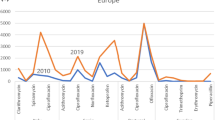Abstract
Biosorption has gained increased attention as a reliable and proven technology for the remediation of industrial effluents rich in chromium. The present study was planned to isolate potential fungi from effluents contaminated sites and assess their efficiency for the absorption and reduction of chromium. Two species of Aspergillus and a species of Trichoderma which were isolated from contaminated sites and exhibited resistance to 10 mM of chromium on agar were chosen for the study. A biosorbent was designed by growing these fungal isolates on luffa sponge under shaken condition. The absorption and reduction of chromium, by the designed biosorbent was determined by Atomic Absorption Spectrophotometry and UV Visible Spectrophotometer. Actively growing fungi on luffa sponge showed better absorption (21%–25%) and reduction (28%–35%) capacity when compared to heat killed biosorbent in all fungi tested within 24 h of incubation. Interestingly, there was a liner increase in the absorption and reduction (85%–100%) of chromium by the biosorbent designed by using A. niger.






Similar content being viewed by others
References
Acosta-Rodríguez I, Arévalo-Rangel DL, Cárdenas-González JF, Moctezuma-Zárate M, Martínez-Juárez VM (2015) Hexavalent chromium (VI) removal by Penicillium sp. IA-01. In: Advances in bioremediation of wastewater and polluted soil, vol. 8, pp 165–192.
Bishnoi NR, Garima N (2005) Fungus- an alternative for bioremediation of heavy metal containing wastewater: a review. J Sci Ind Res 64:93–100
Brady JM, Tobin JM (1995) Binding of hard and soft metal ions to Rhizopus arrhizus biomass. Enzyme Microb Technol 17:791–796
Ezzouhri L, Castro E, Moya M, Espinola F, Lairini K (2009) Heavy metal tolerance of filamentous fungi isolated from polluted sites in Tangier Morocco. Afr J Microb Res 3(2):35–48
Hemambika B, Rani MJ, Kannan VR (2011) Biosorption of heavy metals by immobilized and dead fungal cells: a comparative assessment. J Ecol Nat Environ 3(5):168–175
Iqbal M, Edyvean RGJ (2007) Ability of loofa sponge-immobilized fungal biomass to remove lead ions from aqueous solution. Pak J Bot 39(1):231
Iskandar NL, Zainudin NAIM, Tan SG (2011) Tolerance and biosorption of copper (Cu) and lead (Pb) by filamentous fungi isolated from a freshwater ecosystem. J Environ Sci 23(5):824–830
Liu T, Li H, Li Z, Xiao X, Chen L, Deng L (2007) Removal of hexavalent chromium by fungal biomass of Mucor racemosus: influencing factors and removal mechanism. World J Microbiol Biotechnol 23:1685–1693
Marsh TL, McInerney MJ (2001) Relationship of hydrogen bioavailability to chromate reduction in aquifer sediments. Appl Environ Microb 67:1517–1521
Morales-Barrera L, Cristiani-Urbina E (2008) Hexavalent chromium removal by a Trichoderma inhamatum fungal strain isolated from tannery effluent. Water, Air, and Soil Pollut 187(1–4):327–336
Mungasavalli DP, Viraraghavan T, Jin YC (2007) Biosorption of chromium from aqueous solutions by pretreated Aspergillus niger: batch and column studies. Colloid Surf A 301(1–3):214–223
Murthy KSR, Marayya R (2011) Studies on the removal of heavy metal ions from industrial effluents using Ammonium PyrrolidineDithioCarbamate (APDC) loaded polyurethane foams (PUF). World Appl Sci J 12(3):358–363
Pal N (1997) Reduction of hexavalent chromium to trivalent chromium by Phanerochaete chrysosporium. Situ On-site Bioremediat 2:511–517
Shazia I, Uzma GRS, Talat A (2013) Bioremediation of heavy metals using isolates of filamentous fungus Aspergillus fumigatus collected from polluted soil of Kasur Pakistan. Int Res J Biol Sci 2(12):66–73
Smily JRMB, Sumithra PA (2017) Optimization of chromium biosorption by fungal adsorbent, Trichoderma sp. BSCR02 and its desorption studies. Hayati J Biosci 24(2):65–71
Smith WA, Apel WA, Petersen JN, Peyton BM (2002) Effect of carbon and energy source on bacterial chromate reduction. Bioremediat J 6:205–215
Sukumar M (2010) Reduction of hexavalent chromium by Rhizopus oryzae. Afr J Environ Sci Technol 4(7):412–418
Visoottiviseth P, Ponviroj N (2007) Selection of fungi capable of removing toxic arsenic compounds from liquid medium. Sci Asia 27:83–92
Zafar S, Aqil F, Ahmad I (2007) Metal tolerance and biosorption potential of filamentous fungi isolated from metal contaminated agricultural soil. Bioresour Technol 98(13):2557–2561
Acknowledgements
This work was financially supported by Ministry of Environment, Forest and Climate change (MOEF)- No. 1-39/2012-CT, New Delhi, Government of India.
Author information
Authors and Affiliations
Corresponding author
Additional information
Publisher's Note
Springer Nature remains neutral with regard to jurisdictional claims in published maps and institutional affiliations.
Rights and permissions
About this article
Cite this article
Sriharsha, D.V., Lokesh Kumar, R. & Janakiraman, S. Absorption and Reduction of Chromium by Fungi. Bull Environ Contam Toxicol 105, 645–649 (2020). https://doi.org/10.1007/s00128-020-02979-7
Received:
Accepted:
Published:
Issue Date:
DOI: https://doi.org/10.1007/s00128-020-02979-7




